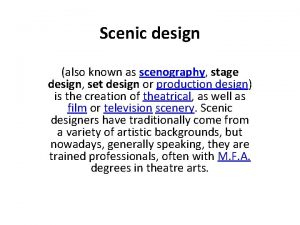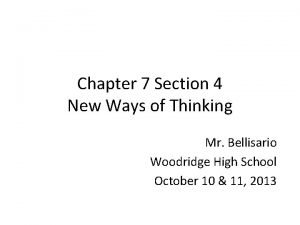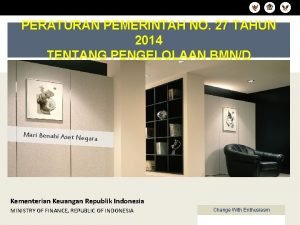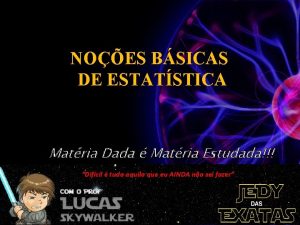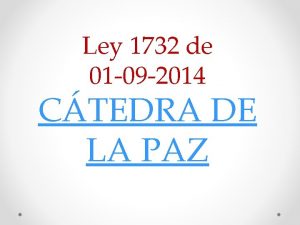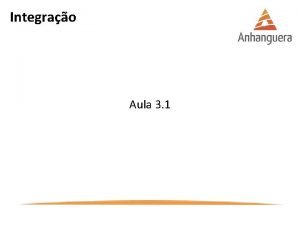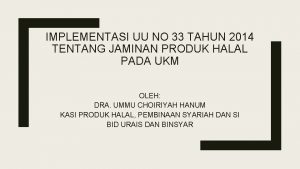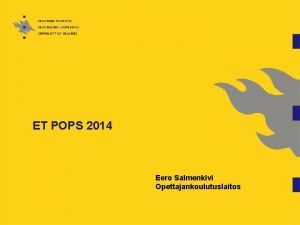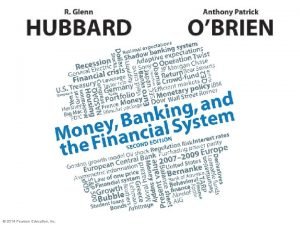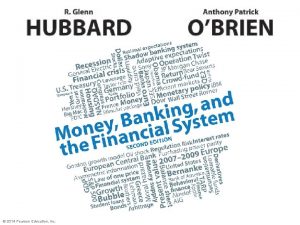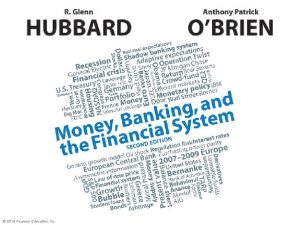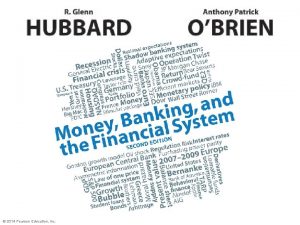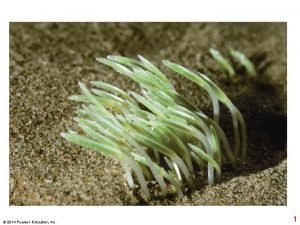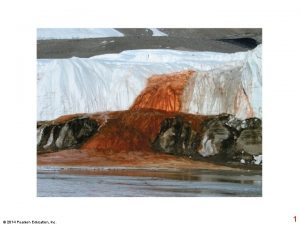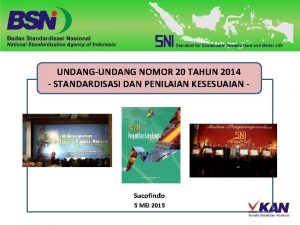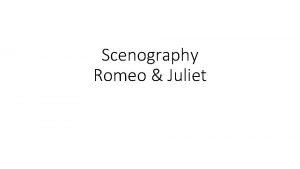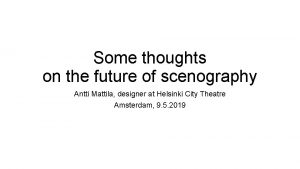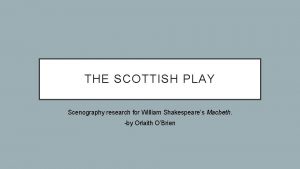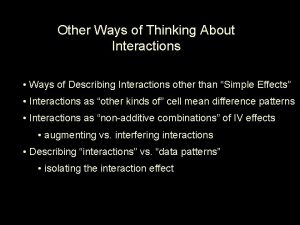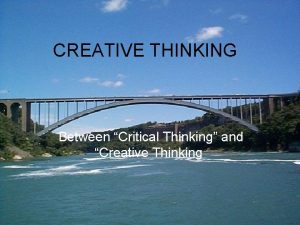Introduction to Scenography DR 2014 Ways of Thinking








































































- Slides: 72

Introduction to Scenography DR 2014 Ways of Thinking about Scenograpahy https: //dr 2014 theatretheory. wordpress. com/

• Define Scenograpahy…. .

A Scenographer is a theatrical designer who specializes in designing all the visual elements of a performance, using a holistic universe approach to conceptualization. http: //www. stephstuff. com/scenography/sceno. html

Scenography - the creation of a stage space does not exist as a self-contained art work. . . Scenography is always incomplete until the performer steps into the playing space and engages the audience. Moreover, scenography is the joint statement of the director and the visual artist of their view of the play, opera or dance that is being presented to the audience as a united piece of work. Pamela Howard. What is Scenogrpahy?

The scenographer has to be an artist who can understand how to work with and incorporate the ideas of the director, understand text as a writer, be sensitive to the needs of a performer exposed to an audience, and create imaginative and appropriate spaces for productions. . also understand music and sound as a musician and composer, movement as a dancer and choreogapher, and the effects of light and shadow as a fine arts painter and a photographer. Pamela Howard, What is Scenography?

The scenographer visually liberates the text and the story behind it, by creating a world in which the eyes see what the ears do not hear. Pamela Howard, What is Scenography?

• Theatre, from the Greek theatron, literally "place for viewing, ” from theasthai "to behold" (related to thea "a view, a seeing)+ tron, suffix denoting place. • http: //www. etymonline. com/index. php? term=theater

Bertrand Russell. Appearance and Reality “Is there any knowledge in the world which is so certain that no reasonable man could doubt it? ”

Colour Circle Made by DTS second years in October 2016

signs our brains attempt to read in order to decipher/infer meaning. (“sense-data”) • Colour • Texture • Shape • Touch • Sound • Smell our experience of those are “sensations”, (whenever we see the colour we have a sensation of it)

Dickie Beau's OLDEN LOBES Speech In Full on Vimeo https: //vimeo. com/200009275

A pioneer of playback performance, emerging from the drag tradition of lip-synching, Dickie Beau is influencing the practice of a whole new generation of performance-makers. His work began to take shape on the alternative drag scene in London’s East End, and is informed by a history that includes classical acting, a crucial period living and working with physical theatre company Teatro Della Contraddizzione in Milan, as well as a significant stint working in Film and TV drama development in the UK. The results defy conventional ideas of what drag performance is and can be, whilst bringing about innovative new theatre experiences, and his process of writing “digital scripts” opens up fresh approaches to writing for performance. “Superb work, demonstrating astonishing technical competence as well as conceptual ambition. ” – The Guardian Dickie’s work is increasingly studied on contemporary theatre and performance courses in the UK and he’s in demand as a workshop leader, teacher and visiting speaker. Dickie is an Associate Research Fellow at both Queen Mary University of London School of English and Drama and at the Birkbeck Centre for Contemporary Theatre, University of London. He has worked as an artistic mentor for SPILL Festival’s National Platform as well as for MA students at Queen Mary University of London and the University of Chichester. http: //dickiebeau. com/biography/

… “what we see is never just matter of simply “just looking”. ” Looking: The Experience of Seeing. Theatre and Performance Design, A Reader. Ed Jane Collins & Andrew Nisbet.

Semiotics – theory and study of signs (Ferdinand de Sauusure) From linguistics where language is made up of units of meaning or signs, each consisting of a “signifier” and a “signified”. The signifier is the sound-image… and the signified is the concept for which the sound-image stands. When applied to visual culture… “The signifier may be thought of as any physical object which has been given a meaning. The signifier may be thought of as the material or physical vehicle of meaning. Thought of in this way, it is the sign’s image as we are able to perceive it visually; it could be gestures, drawn, painted, photographed, computer generated and so on. The signified may be thought of as the meaning that is associated with, or given to , the signifier. It may be thought of as the mental concepts or thoughts that come into one’s head on seeing (or hearing, etc. ), the signifier. ” From The Cambridge Introduction to Scenography.


• The notion that theatre production as a signifying entity, allowed scenography, a part of that entity, to create meaning separately from the text. • • It became necessary to ‘view the performance not as a single sign but as a network of semiotic units belonging to different cooperative systems. ’ • Semiotics gave an avenue into stage spectacle which had previously been considered “too ephemeral a phenomenon for systematic study” • Jiri Veltrusky…‘all that is on stage is a sign”…anything on stage…has the potential to carry dramatic meaning. ’ From The Cambridge Introduction to Scenography.

• Signifier and Signified: Analysis of how communication can occour. “…A table employed in dramatic representation will not usually differ in any material or structural fashion from the item of furniture that the members of the audience eat at, and yet it is in some sense transformed: it acquires, as it were a set of quotation marks. It is tempting to see the table as bearing a direct relationship to its dramatic equivilant – the fictional object it represents – but this is not stricly the case: the material stage object becomes, rather, a semiotic unit standing not directly for another (imaginary) table but for the intermediary signified ‘table’, i. e. for the class of objects of which it is a member. The metaphorical quotation marks placed around the stage object mark its primary condition as representative of its class, so that the audience is able to infer from it the presence of another member of the same class of objects in the represented dramatic world (a table which may or may not be structurally identical with the stage object. )” - Elam

• Charles Sander Peirce identifies: - Icons: resemblance to things to which they refer, photograph, painting, graphic… or costume or prop that represents a real thing - Indices: the work through connection with, or cause and effect of, the thing to which reference is made. Lighting drawing focus, sound emphasising character’s state of mind, costume suggesting status - Symbols: signs which work through agreed conventions. Codes that may require explanation to outsiders. The idea that red shoes might signify a hidden sexual side to a character that appears chaste.

• Iconic Signs (Icons) subdivided into: - Image: which has the appearance of the things to which they refer (Golden, heavy metal crown. ) - Diagram: indicate structural characteristics have a schematic likeness between themselves and the things to which they refer (paper shaped like crown. ) - Metaphor: create or suggest likeness between themselves and the things to which they refer (a circle of twigs placed on the head that the audience understand to be a golden crown. ) Image Icons try to make the spectator forget what they are viewing is not real. Diagramatic and Metaphorical Icons allow and demand a more conceptual understanding of the performance.

• None of these signs can work in isolation or are they fixed. • The study of semiotics is also not able to affix meaning, or is it interested in affixing meaning, rather the analysing of the communication that occours between the object and the viewer/listener

• Aston and Savona offer four levels of operation of the stage picture: - funtionalistic: responding to needs of text - sociometric: how scenography can provide an index of rank and gender - atmospheric: experiential qualities of the fictional place being depicted - symbolic: the stage picture being a metaphorical condensation of the text’s idealogical preoccupations • Like all symbols the comprehension relies on shared understanding between the creators and the receivers

• Aston and Savona consider four stages in making a performance: • 1. The dramatist encodes the text • 2. The director decodes the text • 3. The designer re-encodes the text • 4. The spectator decodes the production

seeing is an embodied experience and phenomenology teaches us that visual perception is always suffused but the other senses. ” …“ Looking: The Experience of Seeing. Theatre and Performance Design, A Reader. Ed Jane Collins & Andrew Nisbet.

• Phenomenolgy. Edmund Husserl and Martin Heidegger • Concerned to account for conciousness in human beings not from a scientific, abstract point of view but from a first-person perspective. • Maurice Merleau-Ponty says phenomonenology is concerned with attempts to capture experience, in direct and ‘primitive’ essence and at a stage before intellectual ananlysis begins to sort, edit and render it as an artificial ‘reconstruction’. • He emphasises that interactions with the world are made up of multiple perspectives…what is seen, heard, felt, sensed, imagined, anticipated and remembered. (These can have a psychophisical response in viewers. )

“semiotics and phenomenology are best seen as complementary perspectives on the world and on art”… (semiotics: objectified, intellectual understanding of signs. ) (phenomenology: total effect of all that the individual spectator apprehends or experiences) “Senses intermingle so that ‘the ear sees scenery and the eye hears it. ’” “ the speeches become a metaphysical light cast on the setting, while the illuminated setting encompasses the speech and gives is a kind of environmental meaning” the interpenetration of sight and hearing may effect the way audience members perceive scenography.

• Di Benedetto… “before interpreting, one needs to have a vocabulary to understand the ways in which an object or experience exists in space. ”

An brief overview of the history of theatre design. Wilde, Larry. http: //www 3. northern. edu/wild/scdes/sdhist. htm

Pre – Renaissance During the Greek, Roman, Medieval and Elizabethan periods, the rear wall of theatre was the scenery. Occasionally, especially during the medieval morality plays, scenic elements, such as the Hells Mouth, were introduced. Generally the scenes location was either obvious, unimportant, or stated in a character's lines. The latter was the standard practice during the Elizabethan Era.

Greek Theatre, the beginning… Theatre of Dionysus, Athens


Herodian Atticus, Tech rehearsal for Carmen May 2007



Roman Theatre at Orange, France

Medieval Theatre Le Matryre de Sainte Apolline from Jehan Fouques miniature


Valenciennes Passion Play

Norah Lambourne’s Drawing of the Valenciennes Passion Play

Elizabethan Playhouses The Fortune

The Globe Theatre


The Italian Renaissance Scenery, as we know it today, is a product of the Italian Renaissance. To a large extent, it is based on the discovery of the rules of perspective and their application to the world of architecture. The early evolution of theatrical scenery is the work of a number of artists over a period of approximately two hundred and twenty five years: 1508 to 1638. Around 1415 - Filippo Brunelleschi. (1377 - 1446) goldsmith, sculpture and architect discovers the secret of linear perspective: a mathematical system for creating the illusion of space and distance on a flat surface. 1435 - Leon Battista Alberti (1404 -1474) publishes Brunelleschi's secret in Della Pitture, the first treatise on the geometric principles of linear perspective. 1508 - Pellegrino da San Daniele (1467 -1547) places individual houses (probably as angled wings) in front of a painted backdrop for a staging of Ariosto's The Casket at Ferrara. 1545 - Sebastiano Serlio (1475 -1554) publishes Architetura the first work detailing the design and construction of a court theatre. Serlio's playhouse was erected in a large existing room (a Hall of State) in the court palace, the standard practice of the day. The stage, located at one end of the room, was raised to the ruler's eye level and the perspective scenery was designed to provide the Royal Chair with a perfect view. The front half of the stage floor was level, the rear half sloped up towards the back wall increasing the illusion of depth. The scenery was placed on the raked (or sloped) portion of the stage. Serlio's sets (Comic, Tragic and Pastoral) consisted of four sets of wings (the first three were angled -- one face parallel to the front edge of the stage and the other angled up stage -- and the fourth wing was flat and parallel to the audience) and a backdrop or back shutter. His sets were conceived in architectural terms. They were not meant to be shifted. 1606 - Giovan Battista Aleotti (1546 -1636) introduces the flat (not angled) wing in Ferrara. 1638 - Nicola Sabbattini (1574 -1654) publishes Practica di fabricar scene e machine ne' teatri (Manual for Constructing Theatrical Scenes and Machines), the first practical stage craft manual.



• The English Renaissance Ingo Jones (1573 -1652), England's first major scene designer, introduced the Italian concept of perspective scenery to the English court theatre of James I in the beginning of the 17 th century. He visited Italy in 1600 returning to his native England four years later. In 1605 he designed a perspective setting using angled wings and a back shutter for a production of Ben Jonson's The Masque of Blackness. By 1608 he was framing his scenery with a proscenium arch and in the 1630 s he abandoned the angled wings of Serlio for the more practical flat wings of Aleotti.

Court Masques and Baroque Theatre Masque Design by Inigo Jones

Costume Drawings by Inigo Jones

Restoration Theatre 1660 -1710

Philip James de Loutherbourg and David Garrick 1771 -1785 • In 1771 de Loutherboug settled in London, where David Garrick paid him £ 500 a year to design scenery and costumes and oversee the stage machinery at the Drury Street Theatre. His stage effects attracted the admiration not just of the general public, but also of artists. He devised scenic effects in which, for instance, green trees gradually became russet and the moon rose and lit the edges of passing clouds: illusions achieved through the use of coloured lantern-slides and the ingenious lighting of transparencies. He continued to work at theatre until 1785.

3 De Loutherbourg sketches for Richard. III from the V&A online collection An example of his painting style

19 th Century Historically accurate scenery The trend towards historically accurate scenery began in Germany around 1810 and is attributed to Josef Schreyvogel, the director of Vienna's Brugtheater. Below are three managers-directors whose emphasis on historical accuracy has impacted the world of design. • • • Actor-manager Charles Kean's (1811 -1868) spectacular antiquarian (historically accurate) productions, especially of Shakespeare's major dramas, dominated the London stage of the 1850 s. He believed that "historical accuracy might be blended with pictorial effect that instruction and amusement would go hand in hand. " He brought centrality of mise en scene to the production of legitimate drama. Georg II (1826 -1914), the Duke of Saxe-Meiningen operated a small, professional court theatre. Like Kean, his sets and costumes were historically accurate. Although he used a realistic style of production, the plays he presented were primarily romantic. His two most frequently revised works were William Shakespeare's Julius Caesar and Frederich Schiller's William Tell. His acting company toured the major cities of Europe for 16 years (1874 to 1890) influencing production techniques in both Paris and Moscow. American producer, director and playwright David Belasco (1853 -1931) is primarily remembered today for his emphasis on naturalistic detail. In 1909, for a production of The Easiest Way, his scenic artist placed the contents of a boarding house room, including the wallpaper, on the stage of the Stuyvesant Theatre and three years later (1912) he built on stage a fully functioning restaurant (Child's Restaurant) for the Governor's Lady. As a playwright he provided the dramatic source material for two of Puccini's most popular operas: Madame Butterfly (1900) and The Girl of the Golden West (1905).

• Development of the box set • As early as 1804, the manager of the Court Theatre at Mannheim (Germany) joined several pairs of wings with door and window flats creating a more realistic scenic environment. • Actor-manager Mme. Vestris (1797 -1856) is credited with introducing the box set to the English stage. In 1832, a critic wrote of one of her productions "the stage's more perfect enclosure fits the appearance of a private chamber infinitely better than the old contrivance of wings. " When Mme. Vestris produced Dion Boucicault's London Assurance at Covent Garden in 1841, the critics noted the realism of the rooms with their heavy molding, real doors with doorknobs, and ample and correct furniture.

The Olympic Theatre, Managed by Madame Vestris

The Whip, Bruce Smith’s “Sensation Scenes”

“The Corsican Brothers” by Dion Boucicault, utilising gauzes etc to facillitate magic like effects

• The New Stage. Craft At the end of the 19 th century, two designers, Adolph Appia (1862 -1928) and Edward Gordon Craig (1872 -1966), revolted against the scenic practices of the traditional European acting company. They objected to a three-dimensional actor standing on a flat floor surrounded by acres of "realistically" painted canvas. Their controversial ideas, published in numerous books and periodicals, would become the basis of the New Stagecraft. A stagecraft of simplification and suggestion.

Adolphe Appia • Adolphe Appia, (1862 -1928) was a Swiss architect, stage designer and theorist of stage lighting and décor. His theories and realized works transformed the practice of stage design and he had a great influence on the development of performing arts • . His sets and his drawings didn’t look for pictorial realism, their intent was rather to create and underline a believable mood for each scene. Symbols and metaphors prevailed over literal descriptions, as in the representation of trees. The actors and the script were of equal importance than scenery: for Appia, the four basic scenic elements were: Painted Scenery (Vertical); Spatial Arrangement (Floor); the Actor; the Light. “Inclusion of the Actor as a scenic element creates a completely new focus with resonance in modenism”. Lucarelli, Fosco. http: //socks-studio. com/2013/12/13/a-revolution-in-stage-designdrawings-and-productions-of-adolphe-appia/

Rhythmic Spaces

Appia's distinctive contribution to this first scenographic turn was in recognising the power and potential of light as both a unifying and expressive force that could be modulated like music. In establishing the fundamental principles of stage lighting, Appia drew attention to the materiality of light, its effect upon stage space and the actor's body within it. Appia therefore evolved a new dramaturgy, with light at its centre, that can also be seen to have influenced such widespread practices as the light plays of the Bauhaus, the work of Czech scenographer Josef Svoboda and the contemporary work of Robert Wilson, for example. Palmer, Scot. A ‘choréographie’ of light and space: Adolphe Appia and the first scenographic turn http: //www. tandfonline. com/doi/full/10. 1080/23322551. 2015. 1024975

Drawing for Orpheus, Hellerau, 1913 Photograph of Orpheus, Hellerau, 1913

Edward Gordon Craig OBE (16 January 1872 – 29 July 1966) Similar to Adolphe Appia in his struggle against the reproduction of reality, Craig envisaged scenic environments designed to appel to the emotion through visual suggestion, evocation and symbolist aesthetics. Without actually meeting until 1914, the two shared and promoted similar ideas on the use of light and stage space: Craig used to lit the stage from above, rather than adopting the traditional foot lighting. Colour and shadow played a strong role in his sets: “Under the play of this light, the background becomes a deep shimmering blue, apparently almost translucent, upon which the green and purple make a harmony of great richness. ” (Craig in Bablet, 1981) His most important scenographic concept was the idea of using neutral, mobile, non-representational screens as a staging device: a system of hinged and fixed flats quickly arrangeable for internal and external scenes. His stage sets were more about a strong sense of mood and atmosphere than naturalism. Movement, action, words, colour and rhytm was used a strong means of conceptualization, combining in a dynamic form. All of his life Craig promoted a visual theatre (he always argued audiences go to see, rather than hear, plays). Design elements have to function as symbols and communicate deeper meanings, rather than simply reflecting the real world. Lucarelli, Fosco http: //socks-studio. com/2014/02/15/to-transcend-reality-and-function-as-symbol-stage-design-of-edward-gordoncraig/


Oskar Schlemmer and the Bauhaus Theatre Oskar Schlemmer, (born September 4, 1888 died April 13, 1943, German painter, sculptor, choreographer, and designer known for his abstract yet precise paintings of the human form as well as for his avant-garde ballet productions.

“Although Schlemmer was one of the important stage artists of the 1920 s, he was not a true man of theatre. The staged works he produced on the Bauhaus stage together with his students, of which there were a large number, were not conceived as works of theatre in the strict sense but as spatializations of compositional strategies. ” – Franz Anton Cramer http: //www. printmag. com/imprint/schlemmer-bauhaus-multimedia-design/

Schlemmer’s Pole dance https: //www. theguardian. com/artanddesign/gallery/2016/nov/24/oskar-schlemmers-ballet-ofgeometry-in-pictures

Caspar Neher and Brecht CASPAR NEHER (1897 -1962) Caspar Neher, who became one of the leading stage designers in Europe from the 1920's until his death in 1962 and was in his youth a schoolmate and friend of Bertolt Brecht, began his career by collaborating with the young author, and later collaborated repeatedly with Brecht and Weill--with both together and each separately.

Aufstieg und Fakk der Stadt Mahagonny Scene sketches by Neher

• • • Epic Theatre proposed that a play should not cause the spectator to identify emotionally with the characters or action before him or her, but should instead provoke rational self-reflection and a critical view of the action on the stage. Neher designed many of the sets for Brecht's dramas and helped to forge the distinctive visual iconography of their Epic Theatre. For this purpose, Brecht employed the use of techniques that remind the spectator that the play is a representation of reality and not reality itself. By highlighting the constructed nature of theatrical event, Brecht hoped to communicate that the audience's reality was equally constructed and, as such, was changeable. The distancing effect or Verfremdungseffekt. Brecht first used the term in an essay on "Alienation Effects in Chinese Acting" published in 1936, in which he described it as "playing in such a way that the audience was hindered from simply identifying itself with the characters in the play. Acceptance or rejection of their actions and utterances was meant to take place on a conscious plane, instead of, as hitherto, in the audience's subconscious”. The distancing effect is achieved by the way the "artist never acts as if there were a fourth wallbesides the three surrounding him [. . . ] The audience can no longer have the illusion of being the unseen spectator at an event which is really taking place”.

Josef Svoboda May 10, 1920 – April 8, 2002 • A czech artist and visionary scenic designer, often called the father of modern theatre design, although he preferred to use the term scenography. He trained initially as an architect and later studied scenography in Prague. From 1948, for over 30 years, he was te leading designer at the Czech National Theatre and during that period he designed all over the world. Co-founder of the Laterna Magika Theatre he became its artistic director in 1993. He was internationally renowned for his innovative use of light and his multimedia installations involving live actors and the use of film projections. (Theatre Performance Design: A reader in Scenography) • Signature elements of his ever-changing environments were projections and later closed-circuit television monitors, which allowed a scene to be to multiplied in space and time. Another key feature were mirrors, sometimes enormous and used to reflect and distort the stage floor. The influence of set designer Adolphe Appia is visible in the strong presence of architectural elements such as majestic stairs and platforms. (http: //www. graphicine. com/josef-svoboda-light-and-shadows/)



Photographs of Svoboda’s work from http: //www. graphicine. com/josef-svoboda-light-and-shadows/
 Scenic design meaning
Scenic design meaning Gods ways are not our ways
Gods ways are not our ways Chapter 7 section 4 new ways of thinking
Chapter 7 section 4 new ways of thinking Vertical arrow technique
Vertical arrow technique Positive thinking vs negative thinking examples
Positive thinking vs negative thinking examples Thinking about your own thinking
Thinking about your own thinking Analytic vs holistic thinking example
Analytic vs holistic thinking example Perbedaan critical thinking dan creative thinking
Perbedaan critical thinking dan creative thinking Thinking about you thinking about me
Thinking about you thinking about me Positive thinking introduction
Positive thinking introduction An introduction to critical thinking and creativity
An introduction to critical thinking and creativity Conclusion paragraph format
Conclusion paragraph format Teacher twins 2014
Teacher twins 2014 Who traditional medicine strategy: 2014-2023
Who traditional medicine strategy: 2014-2023 Teacher twins@2014
Teacher twins@2014 Ddb board regulation #1 s. 2014
Ddb board regulation #1 s. 2014 Ieee 519
Ieee 519 2002-2014
2002-2014 Delinquency report pnp
Delinquency report pnp Hawking
Hawking 2014 special olympics
2014 special olympics Social services and wellbeing act easy read
Social services and wellbeing act easy read Social services and wellbeing (wales) act 2014 easy read
Social services and wellbeing (wales) act 2014 easy read Agosto 2014
Agosto 2014 Sfc 2014
Sfc 2014 Orden 3814/2014
Orden 3814/2014 Sdl trados studio 2014
Sdl trados studio 2014 Riverbed magic quadrant
Riverbed magic quadrant Enade 2014
Enade 2014 Veterinary nurse conduct and discipline rules 2014
Veterinary nurse conduct and discipline rules 2014 Enade 2014
Enade 2014 Teacher twins@2014
Teacher twins@2014 Acsm 2014
Acsm 2014 Gred spm 2014
Gred spm 2014 Siklus pengelolaan aset pada pp 27 tahun 2014
Siklus pengelolaan aset pada pp 27 tahun 2014 Patientlagen 2014:821
Patientlagen 2014:821 Orden 16 de junio de 2014
Orden 16 de junio de 2014 Numa competição esportiva cinco atletas
Numa competição esportiva cinco atletas Microsoft word 2014
Microsoft word 2014 Microsoft powerpoint essentials
Microsoft powerpoint essentials Osslt 2014 answer key
Osslt 2014 answer key Omen 4435/2014
Omen 4435/2014 Ley 1732
Ley 1732 Permendikbud 146 tahun 2014
Permendikbud 146 tahun 2014 © jessica hall (miss señorita) 2014
© jessica hall (miss señorita) 2014 Jessica hall (miss senorita) 2014
Jessica hall (miss senorita) 2014 Libros de jessica hall
Libros de jessica hall Greece 2014
Greece 2014 De acordo com chiavenato (2014) o trabalho industrial
De acordo com chiavenato (2014) o trabalho industrial Implementasi uu no 33 tahun 2014 dilaksanakan pada
Implementasi uu no 33 tahun 2014 dilaksanakan pada Eura 2014
Eura 2014 Pops 2014
Pops 2014 Decreto 1477 de 2014
Decreto 1477 de 2014 Em 385 1 1 2014
Em 385 1 1 2014 E commerce 2014
E commerce 2014 2014 pearson education inc
2014 pearson education inc Irs cbc 2014
Irs cbc 2014 Decizia 2014/955/ue
Decizia 2014/955/ue Computer concepts 2014
Computer concepts 2014 Pengajian am graf kadar perubahan
Pengajian am graf kadar perubahan Give two pieces of advice from tablets
Give two pieces of advice from tablets Contoh pola umum pengajian am
Contoh pola umum pengajian am What are the six key employment generators of ncr?
What are the six key employment generators of ncr? 2015 geografijos egzamino atsakymai
2015 geografijos egzamino atsakymai 2014 pearson education inc
2014 pearson education inc 2014 pearson education inc
2014 pearson education inc 2014 pearson education inc
2014 pearson education inc 2014 pearson education inc
2014 pearson education inc 2014 pearson education inc
2014 pearson education inc 2014 pearson education inc
2014 pearson education inc 2014 pearson education inc
2014 pearson education inc Penn state schedule 2014
Penn state schedule 2014 Uu 20 tahun 2014
Uu 20 tahun 2014
